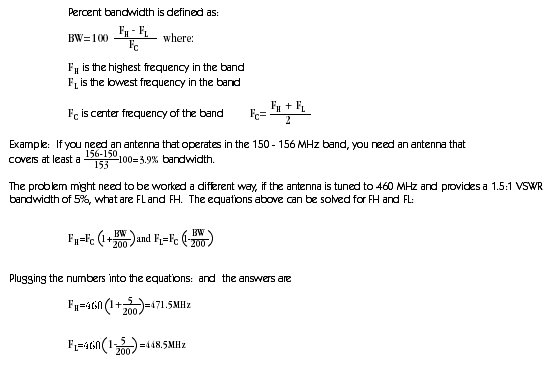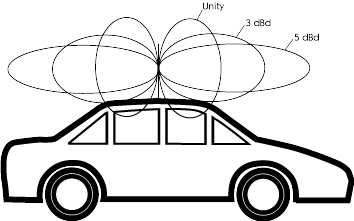
- Basic
Antenna Concepts
Antenna
An antenna is a device that transmits and/or receives
electromagnetic waves. Electromagnetic waves are often
referred to as radio waves. Most antennas are resonant
devices, which operate efficiently over a relatively
narrow frequency band. An antenna must be tuned to the
same frequency band that the radio system to which it is
connected operates in, otherwise reception and/or
transmission will be impaired.
Wavelength
We
often refer to antenna size relative to wavelength. For
example: a half-wave dipole, which is approximately a
half-wavelength long. Wavelength is the distance a radio
wave will travel during one cycle. The formula for
wavelength is:

Note:
The length of a half-wave dipole is slightly less than a
half-wavelength due to end effect. The speed of
propagation in coaxial cable is slower than in air, so
the wavelength in the cable is shorter. The velocity of
propagation of electromagnetic waves in coax is usually
given as a percentage of free space velocity, and is
different for different types of coax.
Impedance
Matching
For efficient transfer of energy, the impedance of the
radio, the antenna, and the transmission line connecting
the radio to the antenna must be the same. Radios
typically are designed for 50 ohms impedance and the
coaxial cables (transmission lines) used with them also
have a 50 ohm impedance. Efficient antenna configurations
often have an impedance other than 50 ohms, some sort of
impedance matching circuit is then required to transform
the antenna impedance to 50 ohms. Radiall/Larsen antennas
come with the necessary impedance matching circuitry as
part of the antenna. We use low loss components in our
matching circuits to provide the maximum transfer of
energy between the transmission line and the antenna.
VSWR
and Reflected Power
The Voltage Standing Wave Ratio (VSWR) is an indication
of how good the impedance match is. VSWR is often
abbreviated as SWR. A high VSWR is an indication that the
signal is reflected prior to being radiated by the
antenna. VSWR and reflected power are different ways of
measuring and expressing the same thing.
A
VSWR of 2.0:1 or less is considered good. Most commercial
antennas, however, are specified to be 1.5:1 or less over
some bandwidth. Based on a 100 watt radio, a 1.5:1 VSWR
equates to a forward power of 96 watts and a reflected
power of 4 watts, or the reflected power is 4.2% of the
forward power.
Bandwith
Bandwidth
can be defined in terms of radiation patterns or
VSWR/reflected power. The definition used in this book is
based on VSWR. Bandwidth is often expressed in terms of
percent bandwidth, because the percent bandwidth is
constant relative to frequency. If bandwidth is expressed
in absolute units of frequency, for example MHz, the
bandwidth is then different depending upon whether the
frequencies in question are near 150, 450, or 825 MHz.

Directivity
and Gain
Directivity is the ability of an antenna to focus energy
in a particular direction when transmitting or to receive
energy better from a particular direction when receiving.
The relationship between gain and directivity: Gain =
efficiency/Directivity. We see the phenomena of
increased directivity when comparing a light bulb to a
spotlight. A 100 watt spotlight will provide more light
in a particular direction than a 100 watt light bulb, and
less light in other directions. We could say the
spotlight has more "directivity" than the light
bulb. The spotlight is comparable to an antenna with
increased directivity. An antenna with increased
directivity is hopefully implemented efficiently, is low
loss, and therefore exhibits both increased directivity
and gain.
Gain
is given in reference to a standard antenna. The two most
common reference antennas are the isotropic antenna and
the resonant half-wave dipole antenna. The isotropic
antenna radiates equally well in "all"
directions. Real isotropic antennas do not exist, but
they provide useful and simple theoretical antenna
patterns with which to compare real antennas. An antenna
gain of 2 (3 dB) compared to an isotropic antenna would
be written as 3 dBi. The resonant half-wave dipole can be
a useful standard for comparing to other antennas at one
frequency or over a very narrow band of frequencies. To
compare the dipole to an antenna over a range of
frequencies requires an adjustable dipole or a number of
dipoles of different lengths. An antenna gain of 1 (0 dB)
compared to a dipole antenna would be written as 0 dBd.
Gain
Measurement
One method of measuring gain is by comparing the antenna
under test against a known standard antenna. This is
technically known as a gain transfer technique. At lower
frequencies, it is convenient to use a 1/2-wave dipole as
the standard. At higher frequencies, it is common to use
a calibrated gain horn as a gain standard, with gain
typically expressed in dBi.
Another
method for measuring gain is the 3 antenna method.
Transmitted and received power at the antenna terminals
is measured between three arbitrary antennas at a known
fixed distance. The Friis transmission formula is used to
develop three equations and three unknowns. The equations
are solved to find the gain expressed in dBi of all three
antennas.
Use
the following conversion factor to convert between dBd
and dBi: 0 dBd = 2.15 dBi.
Antenna
Placement
Correct antenna placement is critical to the performance
of an antenna. An antenna mounted on the roof will
function better than the same antenna installed on the
hood or trunk of a car. Knowledge of the vehicle may also
be an important factor in determining what type of
antenna to use. You do not want to install a glass mount
antenna on the rear window of a vehicle in which metal
has been used to tint the glass. The metal tinting will
work as a shield and not allow signals to pass through
the glass.
Radiation
Patterns
The radiation or antenna pattern describes the relative
strength of the radiated field in various directions from
the antenna, at a fixed or constant distance. The
radiation pattern is a "reception pattern" as
well, since it also describes the receiving properties of
the antenna. The radiation pattern is three-dimensional,
but it is difficult to display the three-dimensional
radiation pattern in a meaningful manner, it is also time
consuming to measure a three-dimensional radiation
pattern. Often radiation patterns are measured that are a
slice of the three-dimensional pattern, which is of
course a two-dimensional radiation pattern which can be
displayed easily on a screen or piece of paper. These
pattern measurements are presented in either a
rectangular or a polar format.
Absolute
and Relative Patterns
Absolute radiation patterns are presented in absolute
units of field strength or power. Relative radiation
patterns are referenced in relative units of field
strength or power. Most radiation pattern measurements
are relative pattern measurements, and then the gain
transfer method is then used to establish the absolute
gain of the antenna.
Near-Field
and Far-Field Patterns
The radiation pattern in the region close to the antenna
is not exactly the same as the pattern at large
distances. The term near-field refers to the field
pattern that exists close to the antenna; the term
far-field refers to the field pattern at large distances.
The far-field is also called the radiation field, and is
what is most commonly of interest. The near-field is
called the induction field (although it also has a
radiation component).
Ordinarily,
it is the radiated power that is of interest, and so
antenna patterns are usually measured in the far-field
region. For pattern measurement it is important to choose
a distance sufficiently large to be in the far-field,
well out of the near-field. The minimum permissible
distance depends on the dimensions of the antenna in
relation to the wavelength. The accepted formula for this
distance is:

When
extremely high power is being radiated (as from some
modern radar antennas), the near-field pattern is needed
to determine what regions near the antenna, if any, are
hazardous to human beings.
Beamwidth
Depending on the radio system in which an antenna is
being employed there can be many definitions of
beamwidth. A common definition is the half power
beamwidth. The peak radiation intensity is found and then
the points on either side of the peak represent half the
power of the peak intensity are located. The angular
distance between the half power points traveling through
the peak is the beamwidth. Half the power is —3dB,
so the half power beamwidth is sometimes referred to as
the 3dB beamwidth.
Antenna
Pattern Types
Omnidirectional
Antennas
For mobile, portable, and some base station applications
the type of antenna needed has an omnidirectional
radiation pattern. The omnidirectional antenna radiates
and receives equally well in all horizontal directions.
The gain of an omnidirectional antenna can be increased
by narrowing the beamwidth in the vertical or elevation
plane. The net effect is to focus the antenna’s
energy toward the horizon.
Selecting
the right antenna gain for the application is the subject
of much analysis and investigation. Gain is achieved at
the expense of beamwidth: higher-gain antennas feature
narrow beamwidths while the opposite is also true.
Omnidirectional
antennas with different gains are used to improve
reception and transmission in certain types of terrain. A
0 dBd gain antenna radiates more energy higher in the
vertical plane to reach radio communication sites that
are located in higher places. Therefore they are more
useful in mountainous and metropolitan areas with tall
buildings. A 3 dBd gain antenna is the compromise in
suburban and general settings. A 5 dBd gain antenna
radiates more energy toward the horizon compared to the 0
and 3 dBd antennas to reach radio communication sites
that are further apart and less obstructed. Therefore
they are best used in deserts, plains, flatlands, and
open farm areas.
Directional
Antennas
Directional antennas focus energy in a particular
direction. Directional antennas are used in some base
station applications where coverage over a sector by
separate antennas is desired. Point to point links also
benefit from directional antennas. Yagi and panel
antennas are directional antennas.

Antenna
Polarization
Polarization is defined as the orientation of the
electric field of an electromagnetic wave. Polarization
is in general described by an ellipse. Two often used
special cases of elliptical polarization are linear
polarization and circular polarization. The initial
polarization of a radio wave is determined by the antenna
that launches the waves into space. The environment
through which the radio wave passes on its way from the
transmit antenna to the receive antenna may cause a
change in polarization.
With
linear polarization the electric field vector stays in
the same plane. In circular polarization the electric
field vector appears to be rotating with circular motion
about the direction of propagation, making one full turn
for each RF cycle. The rotation may be right-hand or
left-hand.
Choice
of polarization is one of the design choices available to
the RF system designer. For example, low frequency (<
1 MHz) vertically polarized radio waves propagate much
more successfully near the earth than horizontally
polarized radio waves, because horizontally polarized
waves will be cancelled out by reflections from the
earth. Mobile radio systems waves generally are
vertically polarized. TV broadcasting has adopted
horizontal polarization as a standard. This choice was
made to maximize signal-to-noise ratios. At frequencies
above 1 GHz, there is little basis for a choice of
horizontal or vertical polarization, although in specific
applications, there may be some possible advantage in one
or the other. Circular polarization has also been found
to be of advantage in some microwave radar applications
to minimize the "clutter" echoes received from
raindrops, in relation to the echoes from larger targets
such as aircraft. Circular polarization can also be used
to reduce multipath.
-
-
-
-
-
-
-
-
-
-
-
-
-
-
-
-
-
|




